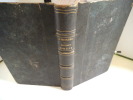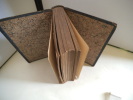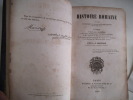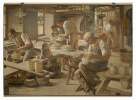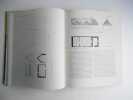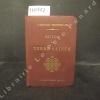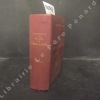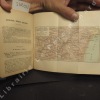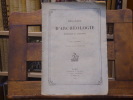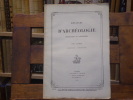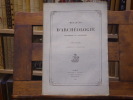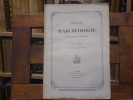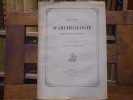-
Type
Any type (2)
Art print (7)
Book (31154)
Disk (1)
Drawings (7)
Engraving (9)
Magazine (129)
Old papers (1)
Photographs (14)
Posters (4)
-
Latest
Last 24h (3)
Last 3 days (102)
Last month (265)
Last week (52)
-
Language
Dutch (1)
English (54)
French (31227)
German (6)
Italian (18)
Japanese (2)
Portuguese (9)
Spanish (11)
-
Century
16th (16)
17th (55)
18th (209)
19th (1566)
20th (9409)
21st (1691)
-
Countries
Belgium (9482)
Brazil (7)
Canada (108)
China (3)
Côte d'Ivoire (67)
Denmark (218)
France (18342)
Germany (1)
Greece (1)
Italy (37)
Switzerland (3062)
-
Syndicate
ALAC (99)
CLAM (42)
CLAQ (94)
CNE (3)
ILAB (10904)
NVVA (1171)
SLACES (1171)
SLAM (8365)
SNCAO (9)
Neujahrsblatt der Künstlergesellschaft in Zürich für 1861 - enthaltend (:) Das Leben des Landschaftsmalers Johann Jakob Meier, von Meilen.
(Zürich), J.J. Ulrich, 1861. 4°. 19 S. Mit lithogr. Porträt von C.F. Irmiger und 1 radierten Tafel von B. Zollinger nach J.J. Meier. Orig.-Broschur (leicht bestossen und angestaubt). = "Der neuen Reihenfolge XXI".
Rohr 1022. - Leicht stockfleckig.
Prestige du passé. Islam.
Coll. "Prestige du Passé", Paris, J. Lazarus, 1987, in-4, br., couv. photo coul. éd., 148 pp., très nb. photos et dessins en coul. et en noir, Un très bon guide pour s'y retrouver dans l'art islamique entre les Omeyades, les Abbasides, les Seldjuqides et l'Empire Ottoman. De très nombreux plans des architectures des bâtiments les plus représentatifs. Pas courant Très bon état
Librairie spécialisée en gastronomie , œnologie et tabagie
Richard Meier Architect
1984, Rizzoli Milano. In-4 soft cover, 411pp. Many illustrations in b&w and color 1984, Rizzoli Milano. In-4 Broché, 411pp. Nombreuses illustrations in b&n et couleur
Book overall in good condition, some light marks on the spine. Nevertheless a good exemplary. Livre en bonne condition. Quelques marques sur le dos mais assez legerès. Neanmoins un bon exemplaire.
Richard Meier Architect.1964/1984.
Rizzoli 1996 1 vol. broché in-4, broché, 411 pp,. 700 reproductions en noir et en couleurs. TEXTE EN ANGLAIS. Reprint de 1996. Très bonne condition.
"Wilmotte : Réalisations et projets (Collection: ""Monographie d'architecture"")"
Le Moniteur. 1993. In-4. Broché. Bon état, Couv. convenable, Dos satisfaisant, Intérieur frais. 229 pages augmentées de nombreuses photos et illustrations en noir et blanc et couleurs dans et hors texte. Couverture contrepliée.. . . . Classification Dewey : 720-Architecture
"Collection: ""Monographie d'architecture"". Préface de François Barré. Classification Dewey : 720-Architecture"
Wilmotte : réalisations et projets.
Paris : Le Moniteur, Collection "Monographie d'architecture", 1993. 229 p. ill. photos coul. et plans.
Musées et espaces d'expositions, espaces commerciaux, bureaux et sièges sociaux, hôtels et habitations, bâtiments publics, architecture intérieure des villes.
Prophéties messianiques. Les Prophéties contenues dans les deux premiers Livres des Rois, avec une introduction sur les types ou figures de la Bible.
Paris, Victor Palmé ; Bruxelles, J. Albanel (Le Mons, E. Monnoyer), 1878 ; in-8, broché ; LXXV (75) pp., 224 pp.
(Caillet, 7323). Les types prophétiques chez les Juifs et du temps de Jésus Christ ; livres de Samuel ; le Messie-Roi ; prophéties d'Anne ; prophétie de Nathan ; importance du Temple ; Jésus Christ réalise la filiation divine ; prophétie des Dernières Paroles ; etc.Couverture un peu défraichie avec tout petit manque en pied du dos et rousseurs éparses.


Phone number : 06 60 22 21 35
J. M. Meiler Architect Chur. Zum Geleit von Gion R. Mohr
Chur, 1933, in-4to, 1 Bl. Text + 33 Tafeln mit je 2 Abbildungen + 6 Bl. Werbung, Original-Leinenband. Leicht fleckig.

(SLACES, NVVA)
Phone number : 41 (0)26 3223808
Bauliche Sanierung von Hotels und Kurorten. Assainissement technique d'Hotels et de Stations turistiques. Schlussbericht/Rapport Final. Zürich, 1945.
4to. Orig. full cloth. 232 pp., textillustr. and 31 ""Planbeilagen"", folded in color.
La maison paysanne et la vie rurale en Suisse.
Lausanne, Payot 1985, 295x230mm, 180pages, nombreuses illustrations, relié toile sous jaquette de l’éditeur. Bel exemplaire.
Pour un paiement via PayPal, veuillez nous en faire la demande et nous vous enverrons une facture PayPal
Histoire Romaine
in 12 demi-chagrin foncé à nerfs,titre,filets dorés,faux-titre,titre,VIII,568 pages,Dezobry E.Magdeleine & Cie 1848. Rousseurs habituelles,plus concentrées en début et fin de volume.
Anmut des Nordens : Wilhelm Heuer und sein graphisches Werk
, Wachholtz verlag, 1996 Hardcover, 288 seiten, Deutsch, 335 x 250 x 30 mm, Wie Neu !!, schutzumschlag, abbildungen in Farbe / s/w. ISBN 9783529051142.
Werkverzeichnis des Hamburger Lithographen Christian Ludwig Wilhelm Heuer (1813-1890). Mit Chronologie der graphischen Werke, Literaturverzeichnis, topographischem und Personenregister.
Töpfer - Hafner.
Dresden, C. C. Meinhold & Söhne o.J. (um 1930). Farbige Lithographie auf festem Papier. Bildformat: 62 x 87 cm.
Schulwandbild. Erschien in der Reihe "Meinolds Handwerkerbilder", Nr. 6. - Mit Gebrauchsspuren.
The 'Alawi Religion: An Anthology
, Brepols - Ecole Pratique des Hautes Etudes, 2021 Paperback, 221 pages, Size:156 x 234 mm, Language: English. ISBN 9782503597812.
Summary The 'Alawi religion, known for most of its history by the name Nu?ayriyya, emerged in Iraq over a millennium ago. An esoteric, syncretistic religion with a close affinity to Shi'i Islam, its origins are shrouded in obscurity. Over time, beliefs and rituals deriving from paganism, Zoroastrianism and Christianity were grafted to the radical Shi'i substrate, giving the religion its distinctive character. Throughout their history the 'Alawites were a persecuted religious minority, but in the 1970s they came to power in Syria and retained absolute rule until recently. There is also a significant population in Hatai Province in southern Turkey. Arising from the authors' long-standing interest in the 'Alawi religion, this anthology offers for the first time a selection from the distinctive literature of the mysterious religion. The book opens with a detailed introduction setting the background for the themes it will cover: the mystery of the divinity in the 'Alawi faith; rituals and ceremonies; calendar and festivals; the doctrine of reincarnation; initiation into the divine mysteries and the esoteric circle; and finally, the identity and self-definition of the religion's followers vis- -vis Islam and other religions. TABLE OF CONTENTS Preface Introduction Chapter 1: The Mystery of the Divinity The trinity 'Ali-Muhammad-Salman and its emanations God's incarnation in human figures: incarnation and docetism Cyclical revelation of the deity Chapter 2: Reincarnation Introduction On the knowledge of the garments of light and the garments of darkness Reincarnation as retribution for the believer's sins The punishment of twenty-four groups of Israelites reincarnated in animals The story of a Nusayri-'Alawi believer reincarnated in a wolf Chapter 3: Antinomianism, Rituals and Festivals Introduction Antinomianism Rituals and Festivals Chapter 4: Initiation Introduction Ta'liq - the spiritual marriage and the bond between master and disciple Sama' - The spiritual pregnancy and birth The rules of the ta'liq The initiation of Sulayman al-Adhani Fulfilment of "the obligatory commandment and the mandatory duty" Chapter 5: Identity and Self-Definition Introduction Muhammad ibn Nusayr - creator of the Nusayri-'Alawi identity The Nusayri-'Alawi identity in the pre-cosmic world and in this world The attitude towards the first two caliphs and to Sunni Islam The figure of 'Ali vis- -vis that of 'Umar Curses against opponents and enemies of the Nusayri-'Alawi religion Mujib al-Murshid in the eyes of his followers Selected sayings of Saji al-Murshid Epilogue: The Ode for the Ghadir Khumm Festival Introduction Ode Bibliography Index
Gabriel Meiring: (ENG
, Snoeck, 2005 Hardcover with dusjacket, 158 pages, very richly illustrated with coloured illustrations. ISBN 9789053495582.
Gabriel Meiring is one of those exceptionally gifted artists who seems to have it all. Not only did he completely transform and review the traditional way of egg-tempera painting, but he also invented the technique of oil-painting on silk. Under the guidance and tuition of great names such as Nadia Boulanger, Nikita Magaloff and Pierre Sancan, he also became an outstanding concert pianist. With flair and ease he can turn his hand to interior design. Furniture, jewellery and fashion design form another outlet for his limitless fantasy and endless creativity. Gabriel Meiring is surely one of the most complete and fascinating artists of our time.
A VERNACULAR ARCHITECTURE OF BRITTANY. An essay in historial geography
1982 A VERNACULAR ARCHITECTURE OF BRITTANY. An essay in historial geography.Edinburgh, John Donald, 1982 , in4°(23x28) relié,jaquette,407pp.Illustrations, plans, cartes..Texte en anglais.Très bon état.
MEISTERMANN, P. Barnabé, O. F. M. (Missionnaire Apostolique)
Reference : 110362
(1923)
Guide de Terre Sainte
1923 A Paris, Chez Auguste Picard, Editeur - 1923 - Nouvelle édition refondue et corrigée - Fort In-12, cartonné, titre doré au dos, titre doré et décor doré sur le premier plat - 748 p. - Avec 26 Cartes et 14 Plans de villes gravés et en couleurs + 110 Plans de monuments dans le texte (dont certaines cartes dépliantes)
Bon état - Menus frottements et légers tassements aux coins
Ulrich Meister: [Ausstellung im Kunstverein Freiburg, Schwarzes Kloster, 10. April-17. Mai 1992
, Edition Patricia Schwarz, 1992 Hardcover with dusjacket 82 pages, illustr. . ISBN 9783925911279.
Edition Patricia Schwarz
Gamle Danske Hjem i Det 16de, 17de og 18de Aarhundrede (+) Nordiske Bøndergaarde i Det XVIde, XVIIde og XVIIIde Aarhundrede. Første Bind: Slesvig + Tillæg).
Kjøbenhavn, 188-92. 4to. Samtidigt hldrbd., rygforgyldning (Anton Larsens Bogbinderi, Kjøbmagergade). 126,(2)22070,(2) pp. Rigt tekstillustreret.
Passage vers l' ternit peintures de la necropole thebaine
, Editions Ozalid, 2000 Hardcover, 191 pages, Francais, 340 x 260 mm, bon etat,. ISBN 9782905904027.
N Tanta, en gypte, le 24 janvier 1911, issu de la diaspora arm nienne, Arpag Mekhitarian est venu se fixer en Belgique, avec sa m re et ses fr res, au milieu des ann es 1920, et y a achev ses tudes secondaires. Invit voquer sa terre natale devant ses camarades de classe, il se rendit, en vue de se documenter, dans les locaux de la jeune Fondation gyptologique. L'allant du jeune homme, sa jovialit et sa ma trise de la langue arabe retinrent l'attention du Directeur, Jean Capart. D s l'automne de 1929, la Fondation s'attachait Arpag Mekhitarian, sa sortie du lyc e. Ainsi commen ait une longue carri re au service de Jean Capart et de la Fondation qu'il dirigeait, plus g n ralement au service de l' gyptologie.?
Mélanges d'archéologie Egyptienne et Assyrienne. Tome premier. 1er fascicule - Novembre 1872.
Librairie A. Franck Paris 1872 In-4 ( 295 X 205 mm ), de 56 pages, broché sous couverture imprimée. Bel exemplaire, non coupé.
Mélanges d'archéologie Egyptienne et Assyrienne. Tome premier. 2e fascicule - Juillet 1873.
Librairie A. Franck Paris 1873 In-4 ( 295 X 205 mm ), paginé 57 à 84, broché sous couverture imprimée. Bel exemplaire, non coupé.
Mélanges d'archéologie Egyptienne et Assyrienne. Tome premier. 3e fascicule - Octobre 1873.
Librairie A. Franck Paris 1873 In-4 ( 295 X 205 mm ), paginé 85 à 118, broché sous couverture imprimée. Bel exemplaire, non coupé.
Mélanges d'archéologie Egyptienne et Assyrienne. Tome premier. 4e fascicule - Juillet 1874.
Librairie A. Franck Paris 1874 In-4 ( 295 X 205 mm ), paginé 119 à 153, broché sous couverture imprimée. Bel exemplaire, non coupé.
Mélanges d'archéologie Egyptienne et Assyrienne. Tome deuxième. 3e fascicule - ( 7e de la collection ).
F. Vieweg, Libraire-Editeur Paris 1875 In-4 ( 295 X 205 mm ), paginé 255 à 302, broché sous couverture imprimée. Petite mouillure au coin supérieur droit, bon exemplaire, non coupé.
 Write to the booksellers
Write to the booksellers






